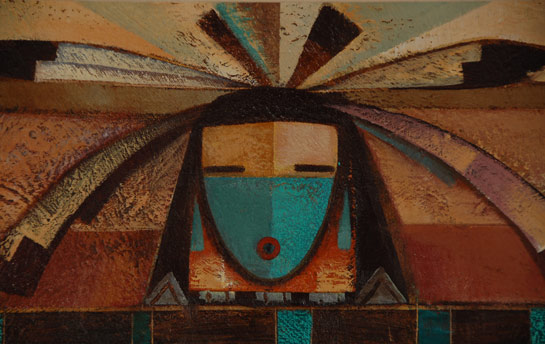Title: Casas Grandes Black on Red Jar with Serpents
Native American belief systems feature a layered perspective of worldly features. It appears that to also be the case with the inhabitants of the Casas Grandes pueblos. Their hierarchy places birds as associated with the sky-Upper World-humans with the Middle World and snakes with the Under World.
Birds and serpents are often represented on pottery from Casas Grandes and human faces often portrayed on effigy vessels. According to authorities, snake presentations are often detailed enough to actually identify the species. There is no indication that snakes were used for subsistence, indicating that they were more revered as spiritually powerful.
In this jar, two serpents are presented in relief, coiled and ready to strike. One of them has a black line painted on its back and the other has black dots over its body. On one side of the jar, two serpentine figures are scratched into the surface of the clay and on the opposing side several serpents are painted in black outlining. Basically each of the serpents is presented differently.
The jar has a small collar rim, below which are two pair of drilled holes through which sinew might have been threaded for the purpose of hanging the jar.
Condition: the jar is in remarkable condition for its age. There are some scratches and abrasions but nothing of significance. There is one hole an inch below the rim which appears to be the result of a probing stick-a technique used by those probing the ground in search of pottery.
Provenance: from the collection of Katherine H. Rust
Recommended Reading: Secrets of Casas Grandes, edited by Melissa S. Powell
Title: Casas Grandes Black on Red Jar with Serpents
Potter Unknown
Category: Pre-Columbian or Prehistoric
Origin: Mexico
Medium: clay, pigment
Size: 6-1/4" tall x 8-3/4" diameter
Item # C3309F
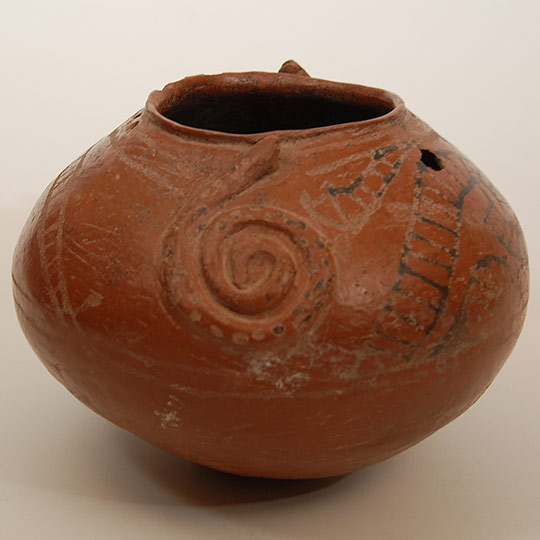
Title: Tesuque Pueblo Rain God Figurine with Large Vessel
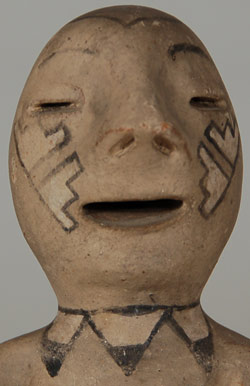 There has been much speculation regarding the origin of Tesuque Rain God figurines. Figurative pottery from New Mexico pueblo potters has a long tradition, at least as far back as 1880 or a little earlier. The earliest documented Rain God from Tesuque was collected in 1879. Figurines were likewise made at Cochiti Pueblo at the same time. There was a thriving market for such through merchants in Santa Fe who sold to visiting tourists as well as through catalogs. Potters at Tesuque responded to requests by merchants to provide curio items for sale by the merchants to the tourist market.
There has been much speculation regarding the origin of Tesuque Rain God figurines. Figurative pottery from New Mexico pueblo potters has a long tradition, at least as far back as 1880 or a little earlier. The earliest documented Rain God from Tesuque was collected in 1879. Figurines were likewise made at Cochiti Pueblo at the same time. There was a thriving market for such through merchants in Santa Fe who sold to visiting tourists as well as through catalogs. Potters at Tesuque responded to requests by merchants to provide curio items for sale by the merchants to the tourist market.
While tourists were enchanted with figurative pottery and purchasing it for their own gratification, museum curators were shunning it as vulgar and low class. Very few of the many thousands of figurines that were made ended up in museum collections at the time. Museum curators felt that merchants were encouraging potters to make cheap kitsch at the expense of producing their traditional fine pottery. What was poorly understood a hundred years ago is now appreciated for its uniqueness and charm.
There is some disagreement among scholars as to the actual origin of Tesuque Rain God figurines. One scholar believes they were a revival of an older figurine pattern. Another believes that the horns, ears, and exaggerated sexual characteristics tie them to Kokopelli, the hump-backed flute player found on rock art. Still another scholar believes they were a rebirth of traditional figurative pottery at Cochiti and Tesuque Pueblos. Lastly, another scholar ties the rain god to pre-Columbian funerary figures and that they were influenced by Mexican wares but interpreted from a unique pueblo perspective.
Regardless of the origin, they have existed as a pottery item from Tesuque Pueblo for at least 135 years
So they are certainly traditional to the pueblo now even if not at that time.
This rain god figurine carries an unusually large pot on its lap. There is a painted design on the head and cheeks and what can be interpreted as a necklace around the neck. The pottery bowl is also decorated.
Condition: very good condition with no damage and some abrasion of the painted surface expected on an item of this age.
Provenance: from the collection of a former Santa Fe resident.
Recommended Reading: When Rain Gods Reigned: From Curios to Art at Tesuque Pueblo by Duane Anderson
Title: Tesuque Pueblo Rain God Figurine with Large Vessel
Potter Unknown
Category: Figurines
Origin: Tesuque Pueblo
Medium: clay, pigment
Size: 5" tall
Item # C3343C
Tesuque Pueblo Rain God Figurine with Hair and Warrior Marks - C3343B
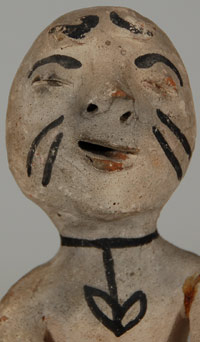 The origin of Tesuque Rain Gods is still somewhat in question. They may be an indigenous development out of a more general Tewa tradition. Before the emergence of the figurine as we know it today, there existed figurines closely related to Kokopelli, the humpbacked, phallic flute player. These early figurines displayed sexual characteristics of male and female genders. A strong similarity exists between these ancestral Rain God figurines and the late 19th-century ones. The sexual characteristics disappeared rapidly once the figurines became commercial products.
The origin of Tesuque Rain Gods is still somewhat in question. They may be an indigenous development out of a more general Tewa tradition. Before the emergence of the figurine as we know it today, there existed figurines closely related to Kokopelli, the humpbacked, phallic flute player. These early figurines displayed sexual characteristics of male and female genders. A strong similarity exists between these ancestral Rain God figurines and the late 19th-century ones. The sexual characteristics disappeared rapidly once the figurines became commercial products.
Their entry into the commercial realm was due to a Santa Fe merchant named Jake Gold and possibly a Chicago, IL Candy Company called Gunther Candy. It has been stated for decades that Gunther offered to buy "Indian relics" to put in their boxes of candy, however this has not been confirmed.
Gold offered Tesuque potters ten cents for each figurine. The potters removed the sexual characteristics from the dolls (probably at the request of Gold) and placed a pot in the lap or on the head. Thus we have the Rain God, as we know it today.
This fine example of a Tesuque Rain God, which probably dates to circa 1900, has sculpted hair and warrior marks on his cheeks. He wears a painted necklace and holds a jar in his lap.
Condition: the left arm has been broken and glued; otherwise the doll is in very good condition for its age.
Provenance: from the collection of a former Santa Fe resident.
Recommended Reading: When Rain Gods Reigned: From Curios to Art at Tesuque Pueblo by Duane Anderson
Title: Tesuque Pueblo Rain God Figurine with Hair and Warrior Marks
Potter Unknown
Category: Figurines
Origin: Tesuque Pueblo
Medium: clay, pigment
Size: 6" tall
Item # C3343B
Title: Diné (Navajo) Set of Four Code Talker Pottery Tiles
Everyone is familiar with the famous Navajo men who are known as the Navajo Code Talkers of World War II. It was they who came up with Navajo words to substitute for naval terms and it was their ingenious use of their Navajo language that confounded the Japanese who were never able to break the code.
Elizabeth Manygoats made a set of four pottery tiles in 2005 illustrating four Navajo words and the naval words for which they substituted. The Navajo word for whale was used for a ship, the word for shark was used for submarine, the word for turtle was used for tank, and the word for bird was used for airplane.
According to Chuck and Jan Rosenak in their book Navajo Folk Art: The People Speak, Betty Manygoats has 10 children-nine daughters and a son-many of whom are making pottery in a style similar to hers. The Rosenaks said that Manygoats was not prolific at the time of their book (1994).
The pottery tiles are mounted on fabric and framed together in a wood frame.
Condition: original condition
Provenance: from the collection of Chuck and Jan Rosenak, renowned collectors and authors of Navajo folk art.
Recommended Reading: Navajo Folk Art: The People Speak by Chuck and Jan Rosenak.
Title: Diné (Navajo) Set of Four Code Talker Pottery Tiles
Potter: Elizabeth Manygoats
Category: Contemporary
Origin: Diné - Navajo Nation
Medium: clay, paint
Size: 4-1/2" x 3-1/2" each tile; 8" x 18-1/2" frame
Item # 25606
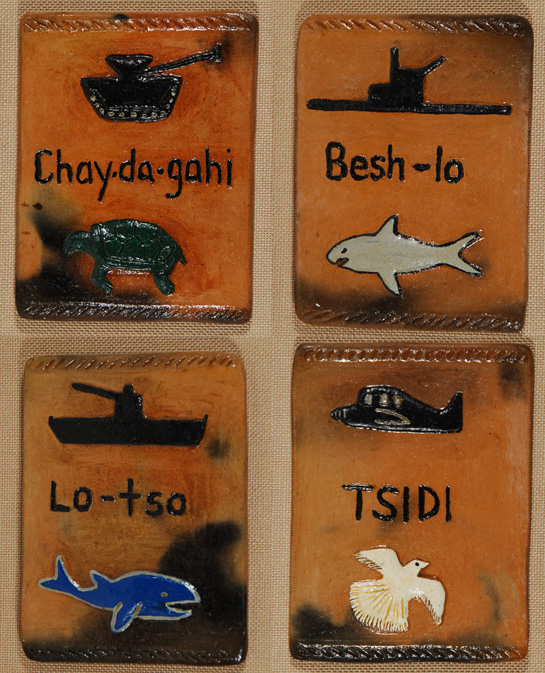
Special Exhibit: The Chuck and Jan Rosenak Collection of Native Art
Chuck and Jan Rosenak were major collectors of folk art when they lived in New Mexico. They authored a couple books on Navajo folk art. Several years ago, they moved to Florida because Jan was having health problems with the altitude in Santa Fe. Chuck informed me that Jan passed away this past summer and he has decided it is time to sell the remaining parts of their collection that they amassed over the years.
We have been selected to sell the collection. There will be many other items of mostly Navajo folk art including wood carvings, pottery, and textiles as well as other Native American items such as Katsina dolls. We will also be happy to provide a letter of provenance with the purchase of any items from their collection.
The exhibit dates are: February 07, 2013 until March 31, 2013.
Biography: Tomás Vigil (1889-1960) Pan-Yo-Pin
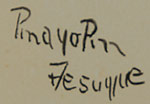 Thomas Vigil (1889-1960) whose Indian name Pan Yo Pin translates to Summer Mountain, was born at Tesuque Pueblo and was among few artists painting there as early as 1914, as witnessed by Santa Fe artist Olive Rush during a trip to Tesuque Pueblo that year. His works of art follow the early tradition of two-dimensional construction with no background or reference plane. His works generally are primitive in style but show much contrast in color value.
Thomas Vigil (1889-1960) whose Indian name Pan Yo Pin translates to Summer Mountain, was born at Tesuque Pueblo and was among few artists painting there as early as 1914, as witnessed by Santa Fe artist Olive Rush during a trip to Tesuque Pueblo that year. His works of art follow the early tradition of two-dimensional construction with no background or reference plane. His works generally are primitive in style but show much contrast in color value.
He was represented in an exhibition in New York in 1927 at what is now the Riverside Museum where "the paintings made a tremendous impression upon the Eastern public, and their spontaneity of conception and real beauty of color, and design, has been praised in the Eastern press." (Forum)
He was also represented in the Exposition of Indian Tribal Arts in New York in 1931. The exposition garnered high praise from art critics such as the New York Times and others.
Biography: Julián Martinez (1885-1943) Pocano - Coming of the Spirits
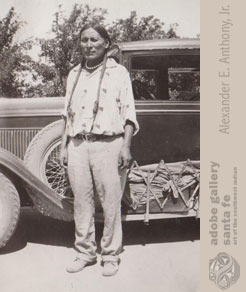 Julián Martinez (Pocano - Coming of the Spirits) was born in 1885 (source: Richard Spivey) in San Ildefonso Pueblo in New Mexico, and died on March 6, 1943 in San Ildefonso Pueblo. He is perhaps best known for the designs he painted on his wife's, Maria's, famous pottery. Martinez had no formal art training. He was the father of Tony Martinez (Popovi Da), also a well known Pueblo artist.
Julián Martinez (Pocano - Coming of the Spirits) was born in 1885 (source: Richard Spivey) in San Ildefonso Pueblo in New Mexico, and died on March 6, 1943 in San Ildefonso Pueblo. He is perhaps best known for the designs he painted on his wife's, Maria's, famous pottery. Martinez had no formal art training. He was the father of Tony Martinez (Popovi Da), also a well known Pueblo artist.
![]() In addition to artist, Martinez listed his occupation as "farmer, laborer, janitor, and pottery designer, " (Lester, p. 343). He also served as Governor of San Ildefonso Pueblo. According to Snodgrass, Martinez had been painting since 1920 and had gone through several periods of ‘realistic' paintings, but some of his more outstanding works were his abstract symbolic and geometric designs found on Maria's pottery.
In addition to artist, Martinez listed his occupation as "farmer, laborer, janitor, and pottery designer, " (Lester, p. 343). He also served as Governor of San Ildefonso Pueblo. According to Snodgrass, Martinez had been painting since 1920 and had gone through several periods of ‘realistic' paintings, but some of his more outstanding works were his abstract symbolic and geometric designs found on Maria's pottery.
Martinez' paintings were among those selected by Mary Jane Colter to decorate the La Fonda Hotel in Santa Fe, New Mexico. He received several commissions for murals, which can be seen at the Santa Fe Indian School; Mesa Verde National Park, Colorado (1935); and at the School of American Research in Santa Fe.
Martinez' paintings are in numerous public collections, including: Amon Carter Museum of Art, Fort Worth, Texas; Amerind Foundation, Dragoon, Arizona; Arizona State Museum, University of Arizona, Tucson, Arizona; Cincinnati Art Museum, Cincinnati, Ohio; Columbus Gallery of Fine Arts, Columbus, Ohio; Cleveland Museum of Art, Cleveland, Ohio; Denver Art Museum, Denver, Colorado; Dartmouth College Collection, Hanover, New Hampshire; Thomas Gilcrease Institute of American History and Art, Tulsa, Oklahoma; Joslyn Art Museum, Omaha, Nebraska; National Museum of the American Indian, Smithsonian Institution, Washington, D. C.; Owensboro Museum of Fine Art, Owensboro, Kentucky; Marion Koogler McNay Art Museum, San Antonio, Texas; Museum of Northern Arizona, Katherine Harvey Collection, Flagstaff, Arizona; American Museum of Natural History, New York, New York; Museum of New Mexico, Santa Fe, New Mexico; Millicent Rogers Museum, Taos, New Mexico; University of Oklahoma Fred Jones Jr. Museum of Art, Norman, Oklahoma; Riverside Museum, New York, New York; School of American Research, Santa Fe, New Mexico; Southwest Museum, Los Angeles, California; University of Pennsylvania Museum, Philadelphia, Pennsylvania; and the Wheelwright Museum of the American Indian, Santa Fe, New Mexico.
REFERENCES:
- Brody, J. J. Pueblo Indian Painting Tradition and Modernism in New Mexico, 1900-1930. Santa Fe, NM: School of American Research Press, 1997.
- Lester, Patrick D. The Biographical Directory of Native American Painters. Tulsa, OK: SIR Publications, 1995.
- Snodgrass, Jeanne O. American Indian Painters: A Biographical Directory. New York, NY: Museum of the American Indian, 1968.
- Wyckoff, Lydia L., ed. Visions + Voices: Native American Painting from the Philbrook Museum of Art. Tulsa, OK: Philbrook Museum of Art, 1996.
Title: Tesuque Pueblo “See, Hear, Speak no Evil” Rain God Figurine Set
According to Duane Anderson, author of When Rain Gods Reigned: From Curios to Art at Tesuque Pueblo, sets of 3 rain god figurines based on the Chinese-influenced "see, hear, speak no evil" form appeared between 1900 and 1925. Less than a dozen sets were found and examined by Anderson during his period of research and only a fourth of them had pots on their laps. He found the earliest set located in the collection at the Heard Museum in Phoenix. That set was reportedly found wrapped in a 1907 newspaper. Anderson speculates that most of this style was made between 1900 and 1910.
This set, from the Rosenak collection, appears to have been made by different potters as the facial features are different. This is not unusual in that most of the figurines were sold as individual items rather than as complete sets. Collectors have sometimes spent years finding all three to complete a set. This set also features pots in the laps of all three figurines. The "see, hear, speak no evil" sets with pottery jars in their laps are the rarest of the style.
Condition: original condition
Provenance: from the collection of Chuck and Jan Rosenak, renowned collectors and authors of Navajo folk art.
Recommended Reading: When Rain Gods Reigned: From Curios to Art at Tesuque Pueblo by Duane Anderson
Title: Tesuque Pueblo "See, Hear, Speak no Evil" Rain God Figurine Set
Potter Unknown
Category: Figurines
Origin: Tesuque Pueblo
Medium: clay, pigment
Size: 6-3/4" tall
Item # 25602
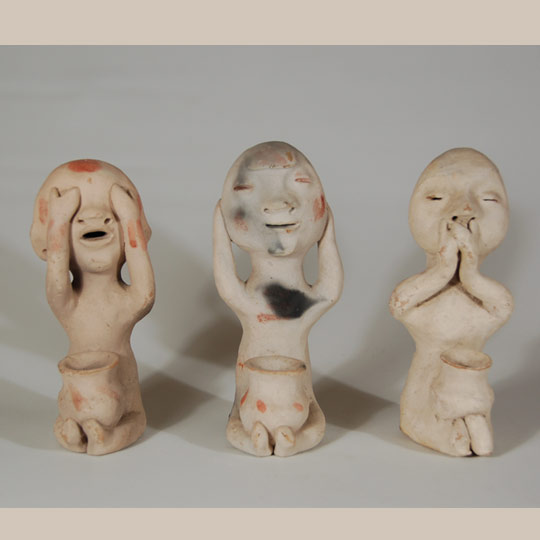
Title: Diné (Navajo) Wedding Vessel with Appliqué Design of a Cow and Horse
Silas and Bertha Claw broke with Navajo pottery tradition and the customs of their fellow tradesmen. Their forms remained true to tradition but they used an appliqué technique for design elements and colorful oil or acrylic paints for highlights. They were of the Shonto/Cow Springs region of the Navajo Reservation. Silas passed away in 2002 but we have found no record of Bertha passing away.
Around 1968, Silas began working in clay even though pottery making, like basket making, was considered women's work. Bertha assisted him from the very beginning. The Claws made a variety of pottery shapes: traditional-style cooking jars, wedding vases, triple-spouted jars, and ceramic beads.
It is not known which one did which part of the production but it is believed Bertha would form the vessels and Silas would decorate them with a variety of appliquéd and incised plant and animal motifs-usually in high relief and occasionally in full round. These motifs depicted a wide range of subjects that included cactus plants and blooming yuccas, oak leaves with acorns, ears of corn, a menagerie of domestic animals, and horned toads. Silas often applied oil paint in a range of colors to portions of the appliqués to make them even more realistic. He then would coat the vessel with varnish.
This wedding vessel has a horse on one side and a cow on the opposing side, both of which are fenced into a corral. Interestingly, each animal has three legs visible but it is assumed that the fourth leg of each is behind one of the others. The vessel was coated in varnish after completion and signed on the underside with the joint signature S. B. Claw.
Condition: original condition
Provenance: from the collection of Chuck and Jan Rosenak, renowned collectors and authors of Navajo Folk Art.
Recommended Reading:
- Navajo Folk Art: The People Speak by Chuck and Jan Rosenak.
- The Navajo Pottery of Silas and Bertha Claw by Ed Dobbins and Scott C. Russell, American Indian Art Magazine, Spring 2007. Vol. 32, No. 2.
Title: Diné (Navajo) Wedding Vessel with Appliqué Design of a Cow and Horse
Potters: Silas and Bertha Claw
Category: Contemporary
Origin: Diné - Navajo Nation
Medium: clay, pigment
Size: 7" tall x 4-1/2" diameter
Item # 25605
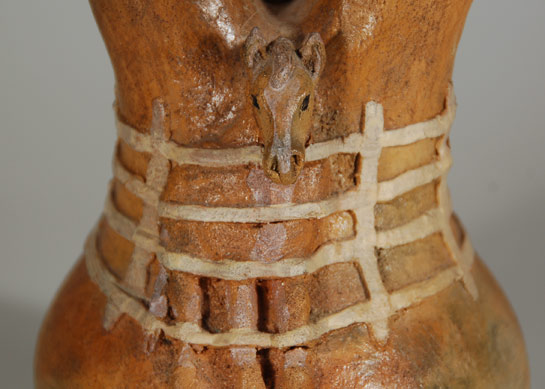
Title: Diné (Navajo) Wedding Vessel with Appliqué Design of toads and cacti
Silas and Bertha Claw were of the Shonto/Cow Springs region of the Navajo Reservation. Silas passed away in 2002 but there is no record of Bertha passing away so it is assumed she is still alive. Around 1968, Silas began working in clay even though pottery making, like basket making, was considered women's work. Bertha assisted him from the very beginning. The Claws made a variety of pottery shapes: traditional-style cooking jars, wedding vases, triple-spouted jars, and ceramic beads.
 It is not known which one did which part of the production but it is believed Bertha would form the vessels and Silas would decorate them with a variety of appliquéd and incised plant and animal motifs-usually in high relief and occasionally in full round. These motifs depict a wide range of subjects that includes cactus plants and blooming yuccas, oak leaves with acorns, ears of corn, a menagerie of domestic animals, and horned toads. Silas often applied oil paint in a range of colors to portions of the appliqués to make them even more realistic. He then would coat the vessel with varnish.
It is not known which one did which part of the production but it is believed Bertha would form the vessels and Silas would decorate them with a variety of appliquéd and incised plant and animal motifs-usually in high relief and occasionally in full round. These motifs depict a wide range of subjects that includes cactus plants and blooming yuccas, oak leaves with acorns, ears of corn, a menagerie of domestic animals, and horned toads. Silas often applied oil paint in a range of colors to portions of the appliqués to make them even more realistic. He then would coat the vessel with varnish.
This vessel features two horned toads on opposing sides and two colorful and blooming cacti on opposing sides. The vessel was coated in varnish after completion and signed on the underside with the joint signature S. B. Claw.
Condition: original condition
Provenance: from the collection of Chuck and Jan Rosenak, renowned collectors and authors of Navajo Folk Art.
Recommended Reading:
- Navajo Folk Art: The People Speak by Chuck and Jan Rosenak.
- The Navajo Pottery of Silas and Bertha Claw by Ed Dobbins and Scott C. Russell, American Indian Art Magazine, Spring 2007. Vol. 32, No. 2.
Title: Diné (Navajo) Wedding Vessel with Appliqué Design of toads and cacti
Potters: Silas and Bertha Claw
Category: Contemporary
Origin: Diné - Navajo Nation
Medium: clay, pigment
Size: 6-3/4" tall x 4-3/4" diameter
Item # 25604
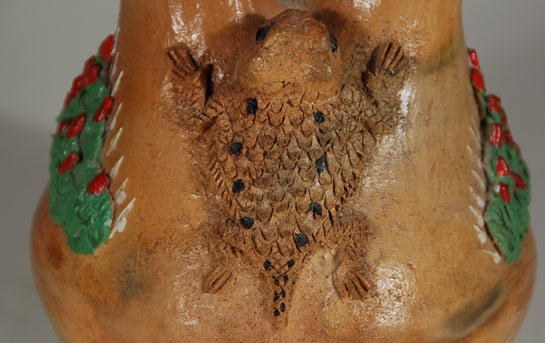
Title: Original Painting of an Indian in a Failed Hunting Event
This painting is certainly of the early 20th century time and was most likely painted by one of the four major painters from San Ildefonso Pueblo—Julián Martinez, Romando Vigil, Richard Martinez or Abel Sanchez. The feather headdress is a typical item seen in San Ildefonso paintings and the yellow paint is identical to the yellow used by Julian Martinez in the painting of an Eagle Dancer figure. The painting is not signed but perhaps a signature was cut off so the image would fit a certain frame.
The painting style is beautifully executed. It is interesting that the artist chose to show a damaged bow string which negated the hunt the young warrior was pursuing. Humor is not often witnessed in these early pueblo paintings.
Condition: appears to be in original condition although it has not been examined out of the frame.
Provenance: from the collection of a Santa Fe resident
Recommended Reading: Modern by Tradition: American Indian Painting in the Studio Style by Bruce Bernstein, et al
Original Painting of an Indian in a Failed Hunting Event
Unidentified Artist
Category: Paintings
Origin: San Ildefonso Pueblo
Medium: watercolor
Size: 10-1/4" x 13-1/4" image; 13-7/8" x 16-7/8" framed
Item # C3342C
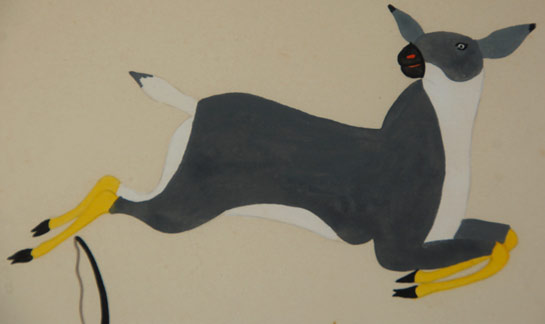
Title: Original Painting of a San Ildefonso Pueblo Eagle Dancer
Julián Martinez is best known for painting the pottery of his wife, Maria Martinez, but he was an accomplished painter as early as 1920, often depicted pueblo dancers and geometric imagery. Once he became totally involved with painting Maria's pottery there was little time for painting easel art.
He was particularly fond of painting warriors on horseback, often changing little but the imagery on the shield or perhaps the body paint on the Indian. He also painted single pueblo dancers such as this Eagle Dancer.
Martinez's paintings were among those selected by Mary Jane Colter to decorate La Fonda Hotel in Santa Fe. He received several commissions for murals at the Santa Fe Indian School; Mesa Verde National Park, Colorado (1935); and at the School for Advanced Research in Santa Fe.
Condition: appears to be in original condition although it has not been examined out of the frame.
Provenance: from the collection of a Santa Fe resident
Recommended Reading: Modern by Tradition: American Indian Painting in the Studio Style by Bruce Bernstein, et al
Title: Original Painting of a San Ildefonso Pueblo Eagle Dancer
Artist: Julián Martinez (1885-1943) Pocano - Coming of the Spirits
Category: Paintings
Origin: San Ildefonso Pueblo
Medium: watercolor
Size: 9-1/4" x 11-1/4" image; 12-7/8" x 14-7/8" framed
Item # C3342B
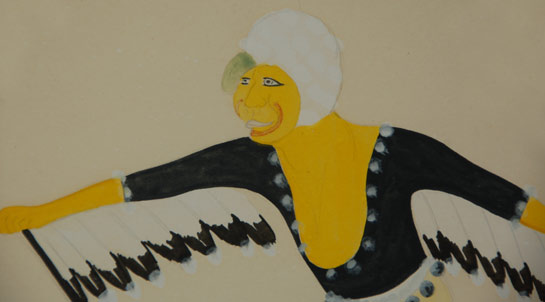
Title: Tesuque Pueblo Original Painting of an Indian on Horseback
It can be said that Tomás Vigil's was of the style of most early 20th century pueblo paintings, that is it was simple, two-dimensional painting. He outlined his intention in pencil before beginning to paint. His colors are strong and show much contrast. His figures generally show considerable action.
Pan-yo-Pin (1889-1960), as he signed his paintings, passed away before the resurgence in Native art occurred in the 1960s, with strong interest witnessed in the 1980s and again in 2005. This interest continues today but works of many artists who passed away around the mid-20th century are not often seen because many of those purchases were not considered important and were not sufficiently protected. Fortunately, this one by Pan yo Pin survived.
This painting is typical of the style painted by several Tewa Indians, especially Julián Martinez and others of that time. The Indian appears more Plains Indian than Pueblo Indian. Perhaps it's the feathers in the hair and on the horse's mane and the face paint, neither of which one associates with Pueblo men.
Condition: appears to be in original condition although it has not been examined out of the frame.
Provenance: from the collection of a Santa Fe resident
Recommended Reading: Modern by Tradition: American Indian Painting in the Studio Style by Bruce Bernstein, et al
Title: Tesuque Pueblo Original Painting of an Indian on Horseback
Artist:Tomás Vigil (1889-1960) Pan-Yo-Pin
Category: Paintings
Origin: Tesuque Pueblo
Medium: watercolor
Size: 11-1/4" x 9-1/4" image; 14-7/8" x 12-7/8" framed
Item # C3342A
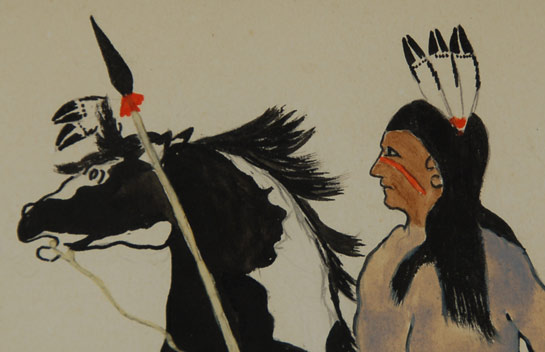
Title: Hopi Small Dish with Corn Plant Design
Since Nampeyo of Hano's era of making pottery at Hopi House at The Grand Canyon, the Hopi have made small souvenir pieces for tourists. This small bowl is typical of such items. It was as carefully made and as carefully decorated as any major piece of pottery. The interior of the bowl is decorated with a full corn plant with developed ears of corn. The exterior is designed with a series of clouds. On the bottom is written, in pencil, Trading Post Second Mesa Hopi Res. Ariz. 200 Jan 22, 1963.
Condition: very good condition
Provenance: from the collection of Jeffrey Trent of Nevada
Title: Hopi Small Dish with Corn Plant Design
Potter Unknown
Category: Contemporary
Origin: Hopi Pueblo
Medium: clay, pigment
Size: 1-1/2" deep x 5" diameter
Item # C3310V
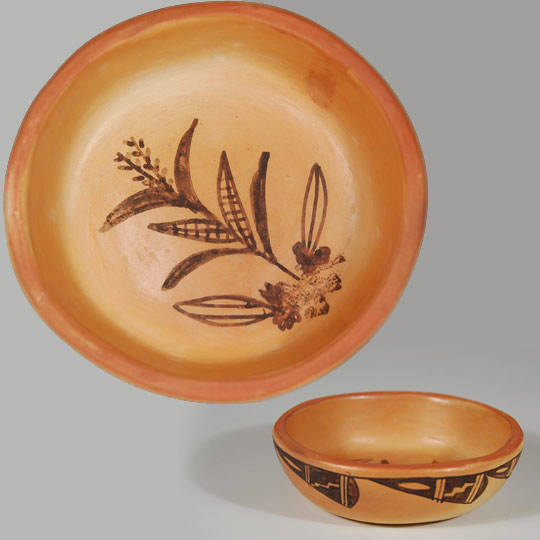
Title: Kewa (Santo Domingo) Pueblo Small Polychrome Bowl
We originally purchased this small bowl in 2005 from Dominguita Aguilar, a Santo Domingo resident with whom we have been friends for a long time. She told us that this was made by Peringrina Aguilar, her mother. I have not been able to find any published reference to this potter, so I do not know what period she worked. The bowl is signed with the initials P.A.N. and S.D.P. (Santo Domingo Pueblo) and a corn stalk image.
This is a fine Santo Domingo small bowl that follows the pueblo's traditions in every aspect of materials, construction and design. The main body is decorated in black vegetal paint and red mineral paint over the cream-colored rag-wiped bentonite slip.
The design consists of rectangular boxes in which a mirror image design is discernible. If one starts with the black-stacked triangles as the center of the design, then the remaining design mirrors outward from there. Double framing lines near the underbody are penetrated by a traditional ceremonial break that goes through the entire design element. A black rim, with a ceremonial break, and red underbody complete the design.
Condition: original condition
Provenance: purchased from Dominguita Aguilar in 2005
ex coll Jeffrey Trent of Nevada
Recommended Reading: A River Apart: the Pottery of Cochiti and Santo Domingo Pueblos by Valerie K. Verzuh
Title: Kewa (Santo Domingo) Pueblo Small Polychrome Bowl
Artist / Potter: Peringrina Aguilar
Category: Contemporary
Origin: Kewa Pueblo (Santo Domingo)
Medium: clay, pigment
Size: 2-1/2" deep x 4-7/8" diameter
Item # C3310U
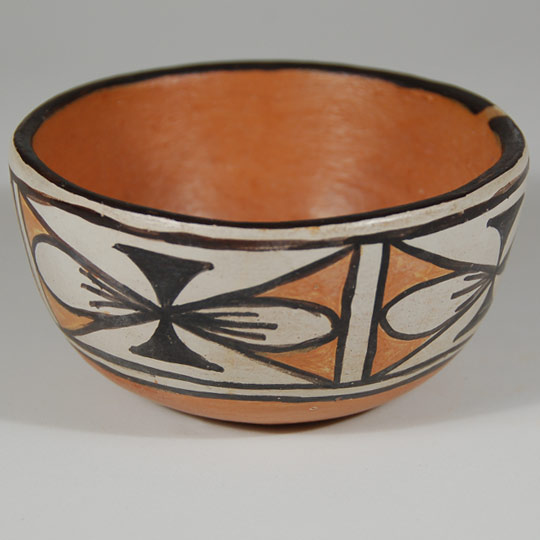
Title: Kewa (Santo Domingo) Pueblo Miniature Cylindrical Pictorial Pot
Thomas Tenorio is of the Aguilar family from Kewa Pueblo. He generally makes very large pottery jars and bowls but apparently early in his career, he made miniatures such as this one. Tenorio learned the art of pottery making by interviewing potters, reading books and by trial and error. For smaller pottery such as this one, he fires outdoors in the traditional manner, but for larger pottery he fires in a kiln similar to the outdoor bread ovens. His larger pottery is therefore protected from wind and fires without fire clouds.
Condition: structurally in excellent condition but there are two scratches and dings that are not noticeable because they are near the bottom of the pot.
Provenance: Edward Busch collection of California
Jeffrey Trent collection of Nevada
Title: Kewa (Santo Domingo) Pueblo Miniature Cylindrical Pictorial Pot
Artist / Potter: Tom Tenorio (1963-present)
Category: Contemporary
Origin: Kewa Pueblo (Santo Domingo)
Medium: clay, pigments
Size: 1-3/4" tall x 1-1/4" diameter
Item # C3310ZD
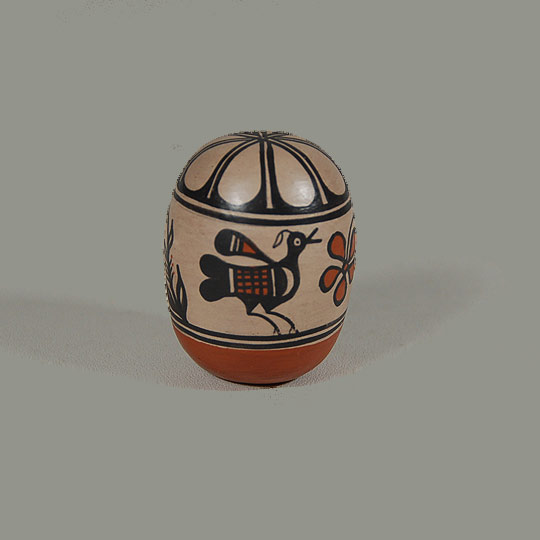
Title: Acoma Pueblo Polychrome Turkey Figurine
This small turkey figurine is signed Norma Jean without the addition of a surname. It is constructed from native Acoma clay and painted with mineral and vegetal paints. What is really charming about it is the way the artisan placed the waddle on the turkey's chest rather than on its neck. Perhaps she is a young potter.
Condition: the piece is well constructed and in excellent condition.
Provenance:
- Private Collector, Toronto, Ontario, Canada
- Jeffrey Trent collection of Las Vegas, Nevada
Recommended Reading: Collections of Southwestern Pottery: Candlesticks to Canteens, Frogs to Figurines [SOLD] by Allan Hayes, et al.
Title: Acoma Pueblo Polychrome Turkey Figurine
Artist / Potter: Norma Jean
Category: Figurines
Origin: Acoma Pueblo
Medium: clay, pigment
Size: 2-1/4" tall x 3-3/4" front to back
Item # C3310ZA
![https://www.adobegallery.com/gallery/43044 This small turkey figurine is signed Norma Jean without the addition of a surname. It is constructed from native Acoma clay and painted with mineral and vegetal paints. What is really charming about it is the way the artisan placed the waddle on the turkey's chest rather than on its neck. Perhaps she is a young potter. Condition: the piece is well constructed and in excellent condition. Provenance: - Private Collector, Toronto, Ontario, Canada - Jeffrey Trent collection of Las Vegas, Nevada Recommended Reading: Collections of Southwestern Pottery: Candlesticks to Canteens, Frogs to Figurines [SOLD] by Allan Hayes, et al.](https://www.adobegallery.com/uploads/C3310ZA-extra2.jpg)
Title: Zuni Pueblo "Pasikiapa" (Wide Sleeves) Katsina Doll
The Pasikiapa Katsina is quite similar in appearance to the Hopi Velvet Shirt Katsina and this is explainable. It appears that the Zuni adopted this Katsina from the Hopi during the 1930s. The Zuni Pasikiapa Dance features a line of male Katsinas accompanied by a single female who functions as the drummer.
To quote Barton Wright:
"The Kachinas are led by an impersonation who bears a definite resemblance to the Hopi Tonei-nili, a side dancer for their Navajo Kachinas. The Hopi Tonei-nili was inspired by the Navajo Gray God, or Water Sprinkler (Franciscan Fathers 1910, 384), and the Zuni Pasikiapa Mosona appears to be closer in form to the Hopi version than to the Navajo (Wright, plate 26c). The kachinas who make up this dance set are apparently derived from several sources, with the main dancers being of Zuni origin, led by an impersonation originating from the Navajo, and accompanied by a drummer, Pasikiapa Tese Akenona Okya (Wright, plate 26d), patterned after a Hopi maiden."
So, in summary, the Hopi created a katsina in honor of a Navajo supernatural and the Zuni adopted the katsina from the Hopi and made it one of their own. This is an interesting display of the inter-relationship of the various Native tribes' beliefs being shared by other tribes. The Pasikiapa Dance is a very popular dance these days in the winter dance season and is a dance presented by one of the kiva groups after the Shalako Ceremony.
Condition: whatever the katsina held in his right hand is missing; otherwise it is in very good condition.
Provenance: from the collection of Chuck and Jan Rosenak, renowned collectors and authors of Navajo folk art.
References:
Franciscan Fathers, An Ethnological Dictionary of the Navajo Language, St. Michaels, Arizona, 1910.
Wright, Barton. Kachinas of the Zuni, Northland Press. 1985.
Burkhardt, Chad. Personal conversation, 2013.
Title: Zuni Pueblo "Pasikiapa" (Wide Sleeves) Katsina Doll
Carver Unknown
Category: Traditional
Origin: Zuni Pueblo
Medium: mixed media
Size: 11" tall
Item # 25603
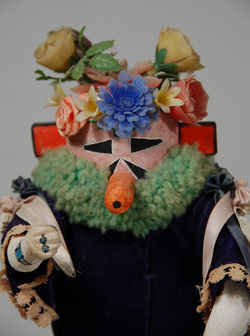
Title: Laguna Pueblo Large Polychrome Olla
This is most likely a Laguna Pueblo polychrome olla that is truly an exceptional work of art. This exemplary olla dates to circa 1920, and is a superb example of the potter's art.
The design field is broken into three horizontal sections, which perfectly accentuate and compliment the form of the jar. The upper band, below rim top, extends to the upper shoulder, with parallelogram bars and floral elements with berries.
The middle design is a continuous bold wide zigzag band that is the focal design element of the vessel. It is filled with black checkerboard, orange checkerboard and overlapping fine line elements.
The lower band of design is similar to the upper band but on a larger and bolder scale.
The underbody is orange. Double framing lines between the design and underbody do not have ceremonial line breaks. The jar has a concave base, brown rim and orange painted on the inside lip to a depth of about 3 inches. There is a slight tilt to the posture of the jar.
This work is perfectly typical of Laguna ceramics, in form, construction, materials, and design execution. The parallelogram bars are very typical of Laguna Pueblo design elements, as are the plants with berries. The plants with berries are a feature taken by Laguna potters to Isleta Pueblo when they migrated there in 1879.
This jar is marvelously patinated, with a smooth, semi-gloss sheen; a complexity of depth, color, and surface completely unattainable save through the intricacies and subtleties of an aged surface, evidence of many years of service within the pueblo.
Condition: the jar is in very good condition with wear expected on a jar of this age. The owner stated that a small rim chip was repaired but there is no clear evidence of that through UV examination.
Provenance: from the collection of a Santa Fe resident.
Recommended Reading: Acoma and Laguna Pottery by Rick Dillingham
Title: Laguna Pueblo Large Polychrome Olla
Potter Unknown
Category: Historic
Origin: Laguna Pueblo
Medium: clay, pigment
Size: 10-1/2" tall x 11-1/4" diameter
Item # C3343A
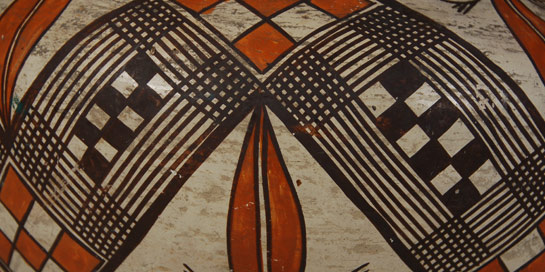
Subject: Original Painting on Canvas of Navajo Imagery by Tony Abeyta
Tony Abeyta has painted in a number of styles over the past few years. He is a creative artist and ventures into new styles and new subjects constantly. We have posted dramatic landscape paintings, colorful Yei figure paintings, and black-and-white imagery in the past.
This is one of his earlier paintings. It features an eagle feather, a most important symbol for Natives, as the central item. Surrounding the eagle feather are four Navajo Yei faces. On the edges of the canvas are images of crescent moons—celestial objects also being most important to Native cultures.
For those who like Abeyta's earlier imagery, here is a chance to acquire one. This one is probably from the 1990s and is in original condition. The canvas has been framed in a wood frame outlining a linen liner.
Condition: original condition
Provenance: from the estate of a Colorado collector
Recommended Reading: 100 Artists of the Southwest by Douglas Bullis
Title: Original Painting on Canvas of Navajo Imagery
Tony Abeyta (b.1965)
Category: Paintings
Origin: Diné - Navajo Nation
Medium: oil on canvas
Size: 45-1/2” x 31-1/2” image; 51-1-2” x 37” framed
Item # C3341
